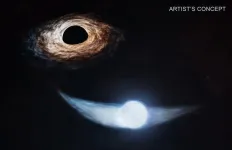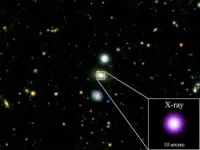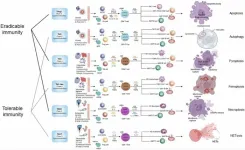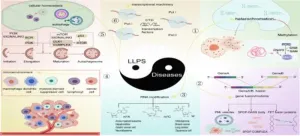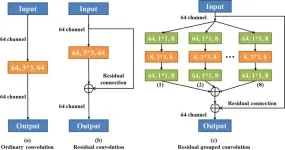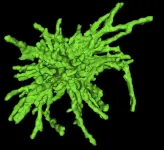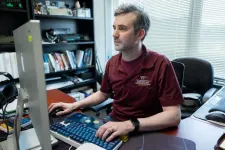(Press-News.org) Powerful telescopes like NASA’s Hubble, James Webb, and Chandra X-ray Observatory provide scientists a window into deep space to probe the physics of black holes. While one might wonder how you can “see” a black hole, which famously absorbs all light, this is made possible by tidal disruption events (TDEs) - where a star is destroyed by a supermassive black hole and can fuel a “luminous accretion flare.” With luminosities thousands of billions of times brighter than the Sun, accretion events enable astrophysicists to study supermassive black holes (SMBHs) at cosmological distances.
TDEs occur when a star is violently ripped apart by a black hole’s immense gravitational field. As the star is shredded, its remnants are transformed into a stream of debris that rains back down onto the black hole to form a very hot, very bright disk of material swirling around the black hole, called an accretion disc. Scientists can study these to make direct observations of TDEs, and compare those to theoretical models to relate observations to physical properties of disrupted stars and their disrupting black holes.
A team of physicists from Syracuse University, MIT and the Space Telescope Science Institute used detailed modeling to predict the brightening and dimming of AT2018fyk, which is a repeating partial TDE, meaning the high-density core of the star survived the gravitational interaction with the SMBH, allowing it to orbit the black hole and be shredded more than once. The model predicted that AT2018fyk would “dim” in August 2023, a forecast which was confirmed when the source went dark last summer, providing evidence that their model delivers a new way to probe the physics of black holes. Their results were published in The Astrophysical Journal Letters.
A High Energy Source
Thanks to incredibly detailed extragalactic surveys, scientists are monitoring more coming and going light sources than ever before. Surveys pan entire hemispheres in search of sudden brightening or dimming of sources, which tells researchers that something has changed. Unlike the telescope in your living room that can only focus visible light, telescopes such as Chandra can detect light sources in what’s referred to as the X-ray spectrum emitted from material that is millions of degrees in temperature.
Visible light and X-rays are both forms of electromagnetic radiation, but X-rays have shorter wavelengths and more energy. Similar to the way in which your stove becomes “red hot” after you turn it on, the gas comprising a disc “glows” at different temperatures, with the hottest material closest to the black hole. However, instead of radiating its energy at optical wavelengths visible to the eye, the hottest gas in an accretion disc emits in the X-ray spectrum. These are the same X-rays used by doctors to image your bones and that can pass through soft tissue, and because of this relative transparency, the detectors used by NASA X-ray telescopes are specifically designed to detect this high-energy radiation.'
A Repeat Performance
In January 2023, a team of physicists, including Eric Coughlin, a professor at Syracuse University’s Department of Physics, Dheeraj R. “DJ” Pasham, a research scientist at MIT, and Thomas Wevers, a Fellow at the Space Telescope Science Institute, published a paper in The Astrophysical Journal Letters that proposed a detailed model for a repeating partial TDE. Their results were the first to map a star’s surprising return orbit about a supermassive black hole – revealing new information about one of the cosmos’ most extreme environments.
The team based their study on a TDE known as AT2018fyk (AT stands for “Astrophysical Transient”), where a star was proposed to be captured by a SMBH through an exchange process known as “Hills capture.” Originally part of a binary system (two stars that orbit one another under their mutual gravitational attraction), one of the stars was hypothesized to have been captured by the gravitational field of the black hole and the other (non-captured) star was ejected from the center of the galaxy at speeds comparable to ~ 1000 km/s.
Once bound to the SMBH, the star powering the emission from AT2018fyk has been repeatedly stripped of its outer envelope each time it passes through its point of closest approach with the black hole. The stripped outer layers of the star form the bright accretion disk, which researchers can study using X-Ray and Ultraviolet /Optical telescopes that observe light from distant galaxies.
While TDEs are usually “once-and-done” because the extreme gravitational field of the SMBH destroys the star, meaning that the SMBH fades back into darkness following the accretion flare, AT2018fyk offered the unique opportunity to probe a repeating partial TDE.
The research team has used a trio of telescopes to make the initial and follow-up detections: Swift and Chandra, both operated by NASA, and XMM-Newton, which is a European mission. First observed in 2018, AT2018fyk is ~ 870 million light years away, meaning that because of the time it takes light to travel, it happened in “real time” ~ 870 million years ago.
The team used detailed modeling to forecast that the light source would abruptly disappear around August 2023 and brighten again when the freshly stripped material accretes onto the black hole in 2025.
Model Validation
Confirming the accuracy of their model, the team reported an X-ray drop in flux over a span of two months, starting on August 14, 2023. This sudden change can be interpreted as the second emission shutoff.
“The observed emission shutoff shows that our model and assumptions are viable, and suggests that we are really seeing a star being slowly devoured by a distant and very massive black hole,” says Coughlin. “In our paper last year, we used constraints from the initial outburst, dimming and rebrightening to predict that AT2018fyk should display a sudden and rapid dimming in August of 2023, if the star survived the second encounter that fueled the second brightening.”
The fact that the system displayed this predicted shutoff therefore implies several distinctions about the star and the black hole:
the star survived its second encounter with the black hole;
the rate of return of stripped debris to the black hole is tightly coupled to the brightness of AT2018fyk;
and the orbital period of the star about the black hole is ~ 1300 days, or about 3.5 years.
The second cutoff implies that another rebrightening should happen between May and August of 2025, and if the star survived the second encounter, a third shutoff is predicted to occur between January and July of 2027.
As for whether we can count on seeing a rebrightening in 2025, Coughlin says the detection of a second cutoff implies that the star has had more mass freshly stripped, which should return to the black hole to produce a third brightening.
“The only uncertainty is in the peak of the emission,” he says. “The second re-brightened peak was considerably dimmer than the first, and it is, unfortunately, possible that the third outburst will be dimmer still. This is the only thing that would limit the detectability of this third outburst.”
Coughlin notes that this model signifies an exciting new way to study the incredibly rare occurrences of repeating partial TDEs, which are believed to take place once every million years in a given galaxy. To date, he says scientists have encountered only four to five systems that display this behavior.
“With the advent of improved detection technology uncovering more repeating partial TDEs, we anticipate that this model will be an essential tool for scientists in identifying these discoveries,” he says.
END
Right on schedule: Physicists use modeling to forecast a black hole's feeding patterns with precision
The dramatic dimming of a light source ~ 860 million light-years away from Earth confirms the accuracy of a detailed model developed by a team of astrophysicists from Syracuse University, MIT and the Space Telescope Science Institute.
2024-08-16
ELSE PRESS RELEASES FROM THIS DATE:
Cell death types and their relations to host immune pathways
2024-08-16
“We have proposed a framework encompassing all discovered host immunological pathways, such as TH1, TH2a, TH2b, TH3, TH9, TH17, TH22, TH1-like, and THαβ immune reactions”
BUFFALO, NY- August 16, 2024 – A new review was published as the cover paper of Aging (listed by MEDLINE/PubMed as "Aging (Albany NY)" and "Aging-US" by Web of Science), Volume 16, Issue 15, entitled, “Types of cell death and their relations to host immunological pathways”.
Various ...
Perceived parental distraction by technology and mental health among emerging adolescents
2024-08-16
About The Study: In a cohort study of 1,300 emerging adolescents ages 9 to 11 across three assessments, higher levels of anxiety symptoms were associated with higher levels of perceived parental technoference later in development. Higher levels of perceived parental technoference were associated with higher levels of inattention and hyperactivity symptoms later in development. The findings of this study speak to the need to discuss digital technology use and mental health with parents and emerging adolescents as a part of routine care.
Corresponding Author: To contact ...
Liquid-liquid phase separation in diseases
2024-08-16
This paper, led by Professor Wu (Wenzhou Institute University, Wenzhou Medical University) and Professor Huang (Northeastern University), explores LLPS, a phenomenon closely associated with various diseases, including cancer and neurodegenerative disorders. As a frontier research area, LLPS plays a significant role in cancer through its regulation of multiple facets, including signaling pathways, gene expression, and tumor microenvironment. Dysregulation of LLPS leads to the formation of various aggregates, such as amyloid proteins, suggesting that modulating LLPS in ...
Advanced U-net segmentation model using residual grouped convolution and attention mechanism for brain tumor MRI image segmentation
2024-08-16
The brain is responsible for the "general command" of human thinking and coordination of the body. Thus, various brain diseases can cause great damage to the human body and nervous system. Brain tumors are caused by abnormal cells that grow and multiply irregularly within the brain. Glioma is one of the most common malignant tumors in adults. It originates from glial cells and the surrounding infiltrating tissue, compresses other normal tissues in the brain during the growth process, and blurs the boundary of the tumor. ...
PolyU develops versatile fluidic platform for programmable liquid processing
2024-08-16
Society relies heavily on diverse fluidic technologies. The ability toprecisely capture and release various chemical and biological fluids plays a fundamental role in many fields.A long-standing challenge is to design a platform that enables the switchable capture and release of liquids with precise spatial and temporal control and accurate volumes of the fluid. Recently, researchers at The Polytechnic University of Hong Kong (PolyU) have invented a new method to effectively overcome this challenge.
Led by Prof. WANG Liqiu, Otto Poon Charitable Foundation Professor in Smart and Sustainable Energy, Chair ...
MIT engineers design tiny batteries for powering cell-sized robots
2024-08-16
A tiny battery designed by MIT engineers could enable the deployment of cell-sized, autonomous robots for drug delivery within in the human body, as well as other applications such as locating leaks in gas pipelines.
The new battery, which is 0.1 millimeters long and 0.002 millimeters thick — roughly the thickness of a human hair — can capture oxygen from air and use it to oxidize zinc, creating a current of up to 1 volt. That is enough to power a small circuit, sensor, or actuator, the researchers showed.
“We think this is going to be very enabling ...
New tool simplifies cell tracking data analysis
2024-08-16
Studying cell migration is vital because it plays a crucial role in many biological processes, including immune response, wound healing, and cancer metastasis. Understanding how cells move and behave can lead to breakthroughs in treating diseases, developing new drugs, and creating innovative therapies. For example, in cancer research, tracking how cancer cells migrate can reveal how tumors grow and spread through the human body. This insight can led to the discovery of more efficient and targeted treatments to stop or even prevent metastasis.
Scientists have introduced CellTracksColab, a tool that simplifies cell tracking data analysis. This free platform leverages advanced ...
Exploring Huntington’s disease, researchers discover that protein aggregates poke holes in nuclear membrane
2024-08-16
Researchers at Utrecht University in the Netherlands have identified a new way in which the toxic protein aggregates associated with Huntington’s disease may damage nerve cells and cause them to die. The study, to be published August 16 in the Journal of Cell Biology (JCB), suggests that the aggregates can poke holes in the membrane that separates the nucleus from the rest of the cell, damaging the DNA inside the nucleus and changing the activity of neuronal genes.
Huntington’s disease is a devastating neurogenerative disorder caused by a mutation in the HTT gene that results in cells producing abnormally large versions of the huntingtin protein. These ...
Why isn't Colorado's snowpack ending up in the Colorado River? New research suggests the problem might be the lack of spring rainfall
2024-08-16
The Colorado River and its tributaries provide water for hydropower, irrigation and drinking water in seven U.S. states and Mexico. Much of this water comes from the snowpack that builds up over the winter and then melts each spring. Every year in early April, water managers use the snowpack to predict how much water will be available for the upcoming year.
But since 2000, these predictions have been incorrect, with the actual streamflow being consistently lower than the predicted streamflow. That’s left water managers ...
New research shows unprecedented atmospheric changes during May's geomagnetic superstorm
2024-08-16
On May 11, a gorgeous aurora surprised stargazers across the southern United States. That same weekend, a tractor guided by GPS missed its mark.
What do the visibility of the northern lights have in common with compromised farming equipment in the Midwest?
A uniquely powerful geomagnetic storm, according to two newly published papers co-authored by Virginia Tech's Scott England.
“The northern lights are caused by energetic, charged particles hitting our upper atmosphere, which are impacted by numerous factors in space, including the sun,” said England, associate professor in the Kevin T. Crofton Department of Aerospace and Ocean Engineering. “During ...
LAST 30 PRESS RELEASES:
Blocking a key inflammatory pathway improves liver structure and vascular function in cirrhosis, study finds
Continuous spread: Raccoon roundworm detected in nine European countries
HKUST Engineering researchers developed a novel photodetector to enhance the performance of on-chip light monitoring
Strategic river sensors could have forewarned of Texas Camp flood disaster
Drone sampling of whale breath reveals first evidence of potentially deadly virus in Arctic
Roman soldiers defending Hadrian’s Wall infected by parasites, study finds
Pinochet’s prisoners were tormented with music but still found solace in it, a new book reveals
Fertility remains high in rural Tanzania despite access to family planning
AI-assisted device can improve autism care access
Kinetic careers
Uncovering how parasitic plants avoid attacking themselves to improve crop resistance
Nanoparticle vaccine strategy could protect against Ebola and other deadly filoviruses
Study finds brain care score can predict risk of stroke across racial groups
Key lung immune cells can intensify allergic reactions
Do hormones explain why women experience more gut pain?
New materials conduct ions in solids as easily as in liquids
Breakthrough of the Year: Renewable energy begins to eclipse fossil fuel-based sources
LLM use is reshaping scientific enterprise by increasing output, reducing quality and more
Introducing LightGen, a chip for ultra-fast, ultra-efficient generative AI
Astronomers see fireworks from violent collisions around nearby star
ACC/AHA issue new guideline on managing congenital heart disease in adults
Cosmic crash caught on camera
Is talented youth nurtured the wrong way? New study shows: top performers develop differently than assumed
Ants: An untapped resource in the development of antibiotics?
Archaeologists use AI to create prehistoric video game
Mitochondria migrate toward the cell membrane in response to high glucose levels
Tiny viral switch offers hope against drug-resistant bacteria
Most parents aware of early peanut introduction guidelines, but confused about details
HPV vaccine can protect against severe lesions of the vulva and vagina
Virtual care provision and emergency department use among children and youth
[Press-News.org] Right on schedule: Physicists use modeling to forecast a black hole's feeding patterns with precisionThe dramatic dimming of a light source ~ 860 million light-years away from Earth confirms the accuracy of a detailed model developed by a team of astrophysicists from Syracuse University, MIT and the Space Telescope Science Institute.
